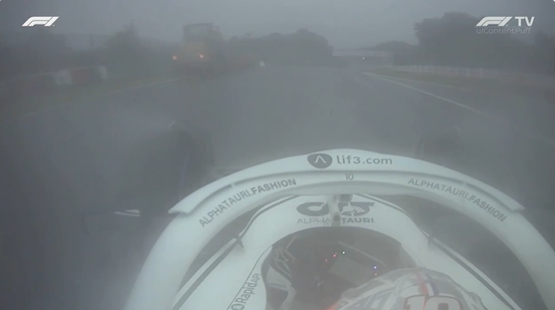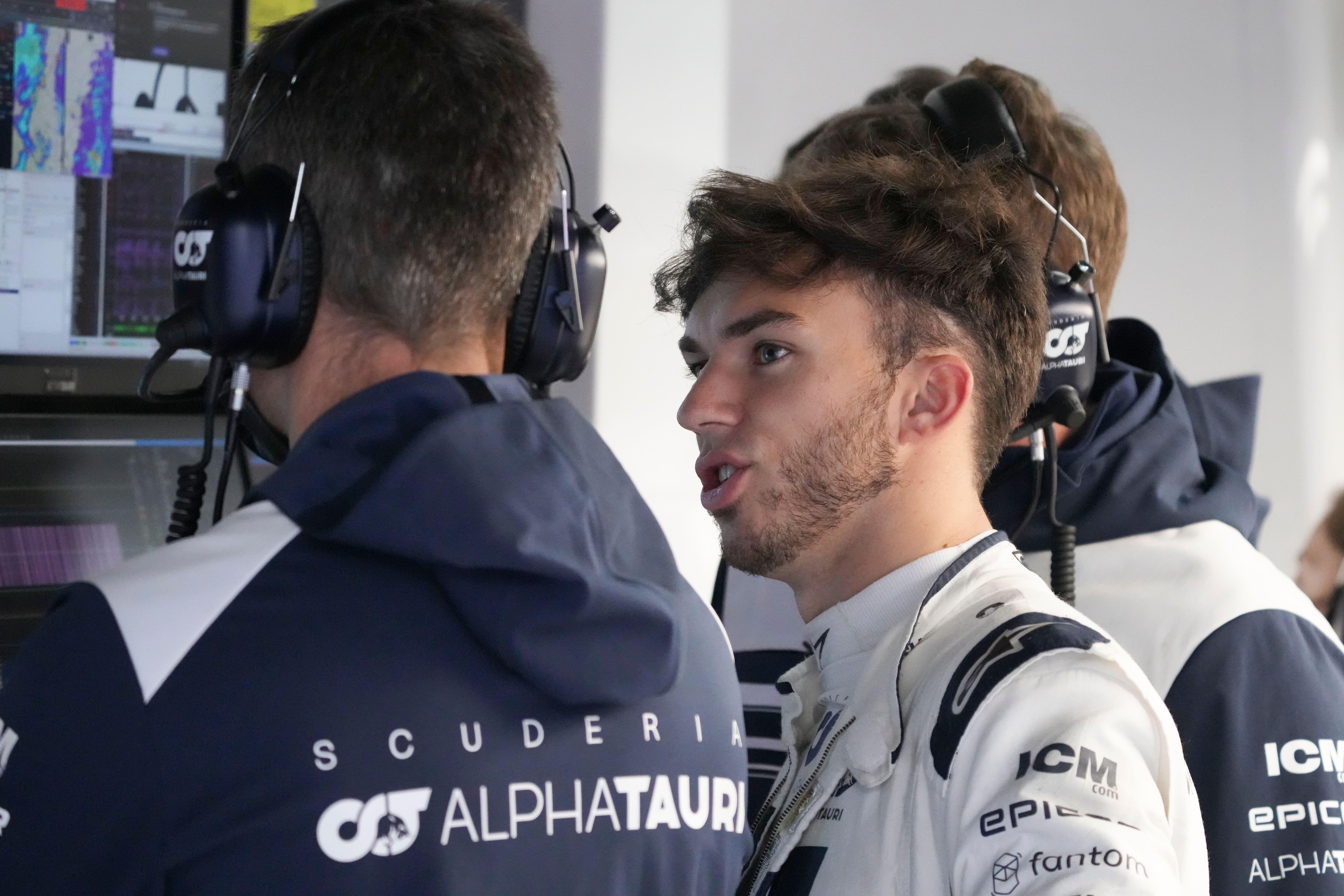After 25 years of warnings not heeded, Pierre Gasly’s close call must be a line in the sand
Formula One was fortuitous in avoiding its darkest day at Suzuka – yet the issue of recovery trucks was raised by Martin Brundle way back in 1998
Pierre Gasly’s frightening near-miss with a recovery truck on Sunday, amid a dangerously damp start to the Japanese Grand Prix, was an incident unlike many others seen in Formula One recently.
Zhou Guanyu’s upside-down flip at Silverstone in July shows that, despite safety advancements such as the life-saving halo, some accidents are still simply a freak of nature. Take Romain Grosjean’s fiery miracle in Bahrain two years ago, too.
But sometimes F1 does not aid its own battle for safety and at Suzuka, the Frenchman and the sport as a whole fortuitously got away with one. The self-inducing controversy continues to swirl.
While comparisons were naturally drawn to Jules Bianchi’s tragic accident on the same track in the same conditions eight years ago – which led to F1’s last racing fatality – the use of recovery vehicles in races is a topic the sport has failed to adequately solve for some time. In fact, it has been a point of contention for at least 15 years.
Warnings have not been heeded.
At the 2007 European Grand Prix at the Nurburgring, a torrential downpour early in the race resulted in seven cars aquaplaning off the racetrack in a matter of seconds at the first corner.
The last of these cars, Vitantonio Liuzzi’s Toro Rosso, rapidly launched itself off the circuit, lightly tapping a truck deployed erratically quickly to recover other stricken cars, such as then-rookie Lewis Hamilton’s McLaren.

Martin Brundle asserted on commentary for ITV: “Crazy to let anything and anybody out there until they’ve neutralised the race… you don’t want to be going underneath one of those digger trucks.” Liuzzi, due wholly to the gravel trap which slowed him down, lived to fight another day.
Rewind further back by another nine years, also in Germany but this time at Hockenheim, Brundle noted while a Tyrrell Ford was being lifted in the air by a tractor in the gravel: “One day someone is going to go underneath that tractor, it really terrifies me.”
As is so often the case, Brundle has been the ultimate voice of reason when it comes to the use of recovery vehicles in Formula One. Yesterday he repeated a sentiment he has aired for nearly three decades, tweeting: “Should NEVER EVER be a tractor on track until the cars are all collected up behind a safety car or in the pits.”

And after Bianchi’s collision with a truck in 2014, the ex-F1 driver – who himself almost hit a recovery vehicle in a crash at Suzuka in 1994 – narrated a pertinent piece for Sky on what measures F1 can implement to lessen the risk, summarising: “Motorsport will always be dangerous, we can’t hide from that fact. Jules Binachi is a fine young man and a shining talent, we couldn’t be more sad. But we must improve and learn from this in his honour.”
On that last point, Bianchi’s father, Philippe, was unequivocal on Instagram on Sunday: “No respect for the life of the driver, no respect for Jules’ memory.” Gasly agreed. His close shave yesterday with a truck wasn’t even in the gravel; it was inches from the racing line.
Yes, the Frenchman was penalised for speeding as he looked to catch the pack following a pit stop, but it is not the key point here.
Simply put: drivers can still lose control of their cars while going slowly, particularly when the elements are of a treacherous nature.

Of course, cars do need to be recovered from the racetrack – and putting out the red flag for every incident is not practical or an appealing solution. Solutions do need to be found though, such as the potential use of cranes off-track and more exits for cars to be rolled away from danger.
Yet the FIA’s handling of Carlos Sainz’s first-lap crash and subsequent spin back into the path of oncoming cars was poor if not completely botched. The red flag should have been immediate given the Ferrari’s position, in which case the use of a truck on track would have been appropriate with the field in the pit lane. It came too late.
The clear breakdown in communication between the marshals and race control as Gasly caught up with the other 17 cars was staggering – and damning of the FIA’s decision-makers in a week which has seen the sport’s governing body under pressure amid the cost-cap row and confusion surrounding points allocated after Sunday’s race, triggering bemusement as to whether Max Verstappen had actually won the World Championship.
Away from sporting matters, though, safety is at the top of the agenda. But actions speak louder than words.
Let it be for Gasly himself – on a weekend which should have been a personal highlight for the right reasons as his move from AlphaTauri to Alpine was announced – to be spot on in his assessment.
“Today it was unnecessary,” an emotional Gasly fumed. “We could have waited one more minute to get back in the pit lane and then put the tractors on track… I pass two metres from that crane, if I was two metres to the left I would have been dead.
“Obviously if I would have lost the car in a similar way as Carlos lost it the lap before it doesn’t matter the speed, 200, 100, I would have just died. Simple as that.”

The FIA have announced an investigation into the timing and use of the recovery vehicle in this instance. An appropriate and necessary response. Yet in a 12-month period which started with focus placed on sacked race director Michael Masi’s handling of incidents between Hamilton and Verstappen, those at the helm in race control face a quest which is tricky to decipher: the compromise between safety and the show in the midst of F1’s stratospheric worldwide boom.
The balance is undoubtedly hard to attain and, sometimes, a perfect solution is not viable. Yet some errors are so avoidable and, if in doubt, safety should be the priority. Sunday’s deployment of the truck points to a system in need of change and clarity, irrespective of the points fiasco.
When drivers are placed in inconceivable danger, a scenario where Red Bull driver Sergio Perez labels the incident the “lowest point we’ve seen from this sport in years” on a day of celebration for his team is damaging for the sport’s reputation.
After 15 years, lessons need to be learned in practice, not just in statements. Gasly’s close call must be a line on the sand – and prompt a change of approach and protocol. Guidance should be sought from safety specialists, experts such as Brundle and most importantly, the drivers. Because, ultimately, the dark day in Suzuka really could have been F1’s darkest day since 2014.
Join our commenting forum
Join thought-provoking conversations, follow other Independent readers and see their replies
Comments

Bookmark popover
Removed from bookmarks